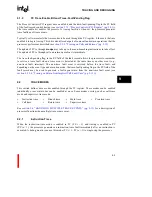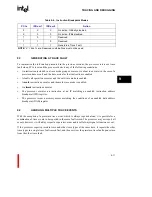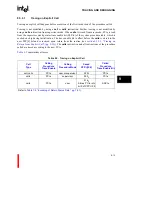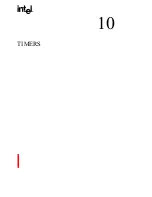
TRACING AND DEBUGGING
9-4
9.2.2
Branch Trace
When the branch-trace mode is enabled in TC (TC.b = 1) and PC.te is set, the processor generates
a branch-trace fault immediately after a branch instruction executes, if the branch is taken. A
branch-trace event is not generated for conditional-branch instructions that do not branch,
branch-and-link instructions, and call-and-return instructions.
9.2.3
Call Trace
When the call-trace mode is enabled in TC (TC.c = 1) and PC.te is set. The processor generates a
call-trace fault when a call instruction (
call
,
callx
or
calls
) or a branch-and-link instruction (
bal
or
balx
) executes. See
section 9.5.2.1, “Tracing on Explicit Call” (pg. 9-13)
for a detailed description
of call tracing on explicit instructions. Interrupt calls are never traced.
An implicit call to a non trace fault handler also generates a call trace if TC.c and PC.te are set
after the call. Refer to
section 9.5.2.2, “Tracing on Implicit Call” (pg. 9-14)
for a complete
description of this case.
When the processor services an explicit call trace fault, it sets the prereturn-trace flag (PFP register
bit 3) in the new frame created by the call operation or in the current frame if a branch-and-link
operation was performed. The processor uses this flag to determine whether or not to signal a
prereturn-trace event on a
ret
instruction.
9.2.4
Return Trace
When the return-trace mode is enabled in TC and PC.te is set. The processor generates a
return-trace fault for a return from an explicit call (PFP.rrr = 000 or PFP.rrr = 01x). See
section 9.5.2.3, “Tracing on Return from Explicit Call” (pg. 9-15)
.
A return from fault may be traced and a return from interrupt cannot be traced. See
section 9.5.2.4,
“Tracing on Return from Implicit Call: Fault Case” (pg. 9-15)
and
section 9.5.2.5, “Tracing on
Return from Implicit Call: Interrupt Case” (pg. 9-16)
for details.
9.2.5
Prereturn Trace
When the TC prereturn-trace mode, the PC.te, and the PFP prereturn-trace flag (PFP.p) are set, the
processor generates a prereturn-trace fault prior to executing a
ret
execution. The dependence on
PFP.p implies that prereturn tracing cannot be used without enabling call tracing. The processor
sets PFP.p whenever it services a call-trace fault (as described above) for call-trace mode.
Summary of Contents for i960 Jx
Page 1: ...Release Date December 1997 Order Number 272483 002 i960 Jx Microprocessor Developer s Manual ...
Page 24: ......
Page 25: ...1 INTRODUCTION ...
Page 26: ......
Page 35: ...2 DATA TYPES AND MEMORY ADDRESSING MODES ...
Page 36: ......
Page 46: ......
Page 47: ...3 PROGRAMMING ENVIRONMENT ...
Page 48: ......
Page 73: ...4 CACHE AND ON CHIP DATA RAM ...
Page 74: ......
Page 85: ...5 INSTRUCTION SET OVERVIEW ...
Page 86: ......
Page 111: ...6 INSTRUCTION SET REFERENCE ...
Page 112: ......
Page 233: ...7 PROCEDURE CALLS ...
Page 234: ......
Page 256: ......
Page 257: ...8 FAULTS ...
Page 258: ......
Page 291: ...9 TRACING AND DEBUGGING ...
Page 292: ......
Page 309: ...10 TIMERS ...
Page 310: ......
Page 324: ......
Page 325: ...11 INTERRUPTS ...
Page 326: ......
Page 369: ...12 INITIALIZATION AND SYSTEM REQUIREMENTS ...
Page 370: ......
Page 412: ......
Page 413: ...13 MEMORY CONFIGURATION ...
Page 414: ......
Page 429: ...14 EXTERNAL BUS ...
Page 430: ......
Page 468: ......
Page 469: ...15 TEST FEATURES ...
Page 470: ......
Page 493: ...A CONSIDERATIONS FOR WRITING PORTABLE CODE ...
Page 494: ......
Page 502: ......
Page 503: ...B OPCODES AND EXECUTION TIMES ...
Page 504: ......
Page 515: ...C MACHINE LEVEL INSTRUCTION FORMATS ...
Page 516: ......
Page 523: ...D REGISTER AND DATA STRUCTURES ...
Page 524: ......
Page 550: ......
Page 551: ...GLOSSARY ...
Page 552: ......
Page 561: ...INDEX ...
Page 562: ......
Page 578: ......















































